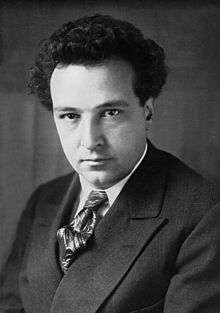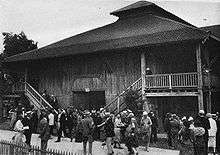Le Roi David
| Le Roi David | |
|---|---|
| Psaume symphonique en trois parties | |
| Oratorio by Arthur Honegger | |
 The composer in 1928 | |
| English | King David / Symphonic Psalm in Three Parts |
| Text | by René Morax |
| Language | French |
| Based on | King David's life |
| Performed | 12 May 1938: Basel |
| Movements | 27 |
| Scoring |
|
Le Roi David was composed in Mézières, Switzerland, in 1921 by Arthur Honegger, as incidental music for a play in French by René Morax. It was called dramatic psalm, but has also been performed as oratorio, without staging. The plot, based on biblical narration, tells the story of King David, first a shepherd boy, his victories in battle, relationship to Saul, rise to power, adultery, mourning of his son's death, and finally his own death.[1] The work has 27 musical movements, some instrumental, most for voices and orchestra. A narrator connects the scenes, soloists take different roles.
Arthur Honegger was commissioned to write incidental music to accompany René Morax’s play Le Roi David in 1921. Honegger was given the nearly impossible deadline of 2 months to complete the work and was rewarded with much acclaim at the premiere. In 1923 he combined Morax’s narrative with his music and created a "symphonic psalm," the form that is familiar today, and titled his work Le Roi David.[2]
Instrumentation

Original 1921 version: Honegger originally wrote his Le Roi David music for the forces that were available at Morax's Mézières village theatre group, creating a score for the resources available; a small ensemble of 16 musicians comprising: 2 flutes [1 doubling piccolo], 1 oboe [doubling cor anglais], 2 clarinets [1 doubling bass clarinet], 1 bassoon [doubling contrabassoon], 1 horn, 2 trumpets, 1 trombone, timpani, 1 percussionist (playing snare drum, bass drum, cymbals, tambourine, and tam-tam), piano, harmonium, celesta and 1 double bass. It was premiered there on 11 June 1921.
In 1923, bolstered by the success of the original version, Honegger re-scored the work for a standard orchestra of 2 flutes [1 doubling piccolo], 2 oboes [1 doubling cor anglais], 2 clarinets [1 doubling bass clarinet], 2 bassoons [1 doubling contrabassoon], 4 horns, 2 trumpets, 3 trombones, tuba, timpani, snare drum, bass drum, cymbals, tambourine, tam-tam, organ, celesta, harp, and strings) accompanying a chorus (often singing antiphonally or in unison), soprano, alto, tenor, and boy soprano soloists, a narrator and an actress for nº 12 – Incantation Scene (Saul and the witch of Endor). The music is separated into 27 mostly brief sections and features many individual instruments.
Structure
The work is structured in three parts, the movements numbered to 27 in the 1952 edition (28 in the first edition).[3]
| No. | Title | Translation | Text source | Voices |
|---|---|---|---|---|
| 1 | Introduction | |||
| 2 | Cantique du berger David | The Song of David, the Shepherd | A | |
| 3 | Psaume: Loué soit le Seigneur | Psalm: All Praise to Him | Psalm | SATB |
| 4 | Chant de victoire | Song of Victory | SATB | |
| 5 | Cortège | March | ||
| 6 | Psaume: Ne crains rien | Psalm: In the Lord I Put my Faith | Psalm | T |
| 7 | Psaume: Ah! si j'avais des ailes de colombe | Psalm: O Had I Wings Like a Dove | Psalm | S |
| 8 | Psaume - Cantique des Prophètes | Song of the Prophets | men's chorus | |
| 9 | Psaume: Pitié de moi, mon Dieu | Psalm: Have Mercy on Me, my Lord | Psalm | T |
| 10 | Le Camp de Saül | Saul's Camp | ||
| 11 | Psaume: L'éternel est ma lumière infinie | Psalm: God, the Lord Shall Be my Light | SATB | |
| 12 | Incantation | Incantation | A (speaking) | |
| 13 | Marche des Philistins | March of the Philistines | ||
| 14 | Lamentations de Guilboa | The Lamentations of Gilboa | Women's chorus | |
| No. | Title | Translation | Text source | Voices |
|---|---|---|---|---|
| 15 | Cantique de fête | Festival Song | women's chorus | |
| 16 | La Danse devant l'arche | The Dance before the Ark | SATB | |
| No. | Title | Translation | Text source | Voices |
|---|---|---|---|---|
| 17 | Cantique: De mon cœur jaillit un cantique | Song: Now my Voice in Song Upsoaring | SATB | |
| 18 | Chant de la servante | Song of the Handmaid | A | |
| 19 | Psaume de pénitence | Psalm of Penitence | SATB | |
| 20 | Psaume: Je fus conçu dans le péché | Psalm; Behold, in Evil I Was Born | SATB | |
| 21 | Psaume: Je lève mes regards vers la montagne | Psalm: O Shall I Raise mine Eyes unto the Mountains? | T | |
| 22 | La Chanson d'Ephraïm | The Song of Ephraim | S women's chorus | |
| 23 | Marche des Hébreux | March of the Hebrews | ||
| 24 | Psaume: Je t'aimerai, Seigneur, d'un amour tendre | Psalm: In my Distress | SATB | |
| 25 | Psaume: Dans cet effroi | Psalm: In this Terror, the Great God which I Adore | SATB | |
| 26 | Couronnement de Salomon | The Coronation of Solomon | ||
| 27 | Mort de David | The Death of David | S SATB | |
Plot
Le Roi David is divided into three main parts and tells the biblical story of King David. In the first part, the Lord directs the prophet Samuel to choose Saul as the ruler of the people of Israel. However, when Saul does not follow the Lord’s instructions, Samuel is told to place David as ruler. The first part continues to tell the story of David’s battles against the Philistines as well as Saul’s growing jealousy of David. The second part covers David’s crowning and unification of Israel. The third and final part tells of David’s lust for Bathsheba and his punishment for adultery. In this final section of the piece, David flees Jerusalem, loses his power, manages to restore his position as king then offends God by censuring the people. An epidemic disease afflicts Jerusalem, and David appoints his son Solomon to succeed him and then dies. At the end of the piece an angel tells of Isaiah’s prophecy of a flower blooming from David’s stem.[4]
Analysis of text and music
The most significant element of Le Roi David is the combination of different styles of music in one complete work. Honegger uses compositional techniques ranging from Gregorian chant to Baroque to jazz. Honegger’s utilization of all of these concepts allowed him to make a serious contribution to the neoclassical era. The music is full of with thematic gestures and is most often performed in French.[5]
References
- ↑ Letellier, Robert Ignatius (2017). The Bible in Music. Cambridge Scholars Publishing. pp. 272–273. ISBN 9781443868488.
- ↑ Classical Net Article – Honegger – Le Roi David
- ↑ Le Roi David. Edition Faetisch. 1952.
- ↑ Arthur Honegger's King David Francis Poulenc's Gloria
- ↑ A History of Western Music, Burkholder
External links
- Texts and English language translations
- Michael Steinberg: The Symphony: A Listener's Guide Oxford University Press 1995
- Honegger / King David Gramophone 2014
- Robert S. Hines: Arthur Honegger's Three Versions of "King David" Choral Journal 2006